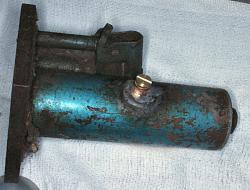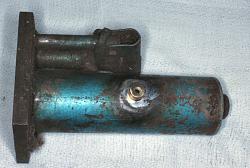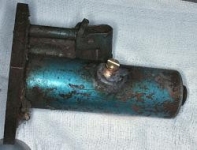Upon arrival back home from the lake, I unhitched the boat and put a big flat steel disc under the tongue jack wheel so it wouldn’t dig into the dirt. The tongue jack wheel was oriented sideways, perpendicular to the tongue.
I jacked the tongue off the trailer hitch. It promptly rolled sideways off the big steel disc and dug into the dirt.
“Oh golly”, I said, “jist lookit that wouldja then!” Well, something like that, anyway. That's how we tawk in Minnesota doncha know.
It was then in a position where If I used the tongue jack to put it back on the hitch, there wouldn't be enough swing room under it to stow the tongue jack. I muttered the F-word. (Fooey!) I’d need to jack up the tongue with another jack.
Hey, no problem, I got jacks! I dug out an old bottle jack that I probably haven’t used for at least a decade and maybe two -- and it was old when I got it because it came with my ’76 Blazer. It’s a pretty good little jack, made in USA, not one of those Chinese wonders.
I got the jack in place under the tongue (of the trailer, not mine), blocked and chocked until I had enough altitude, started stroking the jack. It went up about half an inch and stopped.
“Oh golly”, I said, “just lookit that wouldja then!” Well, something like that, anyway. The jack was out of oil. Nearly all of the hydraulic oil had leaked out of it over the years. Hey, no problem, I was sure I had a bottle of hydraulic jack oil that I bought in, oh, maybe 1995 or so.
Yup, there it was, right where I thought it might be in my object-rich environment – and it was half full!
I pulled the little rubber stopper out of the jack. I got it out in once piece, but barely. It’s toast. My pretty-good old jack was now stopper-less as well as oil-less.
But I have a machine shop, and I’m retired so I have time to mess with stuff like this! Only other things I had to do was unpack and do laundry anyway, and machine shop beats laundry any day.
I found a piece of .562” (9/16”, I guess) diameter brass rod in my raw stock rack. Purr-fick! The body of the jack is 2-3/8” diameter, so I set up a Criterion boring head in the mill to cut such a curve and milled the end of the rod to fit snugly against the jack body. I then brought it back to the lathe, drilled it and tapped it ¼” -28 and cut it off.
Then I silver-brazed this bit to the jack body. The hole in the jack body was about 5/16” dia so I didn’t have any trouble keeping the ¼” hole in the new part more or less centered over the 5/16” hole in the jack body while brazing. There’s a bright, shiny fillet all the way round so I know that joint will never leak.
There was about no oil left in the jack and what was left was lying opposite the heated part, so no problem with brazing heat on the body. After doing the braze I quenched it with a squirt bottle of water. The whole process went quickly enough so I doubt that the under side even got too warm to touch. You can see that paint less than an inch away from the joint didn’t blister. The joint had to be at about 1300 degrees F to melt the silver brazing alloy so it would wet the metal and flow freely, but the oxyacetylene flame is very hot (more than 5000 degrees) so the region under the flame heats quickly. Steel isn’t a very good conductor of heat so the key is to get ‘er done and quenched before neighboring regions notice: get in and outta there like a surgeon with a golf date.
Then I made a very short ¼-28 brass screw with a head having the same diameter as the new fitting. Well duh, I made the screw from the same brass rod stock. I put a buna-N (material that is impervious to oil) O-ring on the screw. When the screw is snug, the O-ring gets compressed to form a leak-proof seal. Better than factory!



 LinkBack URL
LinkBack URL About LinkBacks
About LinkBacks



 Reply With Quote
Reply With Quote




Bookmarks